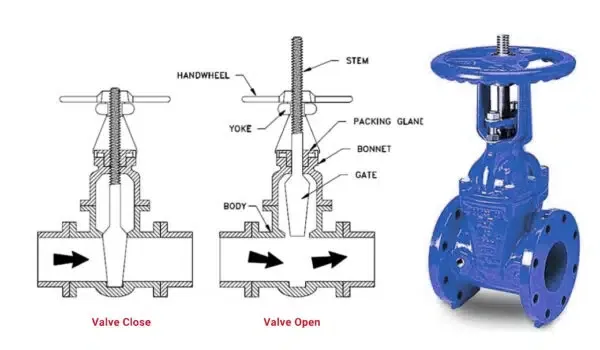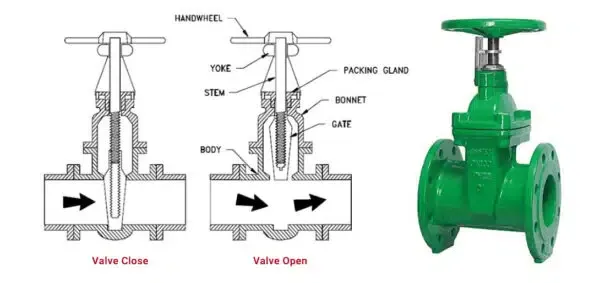Gate valves are a cornerstone of industrial fluid control systems, playing a crucial role in managing the flow of liquids or gases through pipelines. Among the various designs, rising stem gate valves and non-rising stem gate valves are two widely used types, each with distinct features and applications. This article provides an in-depth comparison of these two valve designs to help you choose the best option for your specific requirements.
A rising stem gate valve features a threaded stem located externally to the valve body. When the handwheel is rotated, it interacts with a nut located within the valve’s bonnet. This motion causes the stem to move upward (open position) or downward (closed position). This external movement of the stem provides a clear visual indication of the valve's status, making it easy to identify whether the valve is open or closed.

Rising stem gate valves are constructed using durable materials such as cast iron, stainless steel, and corrosion-resistant alloys. These materials ensure long service life, even in demanding environments.
The design incorporates exacting tolerances and advanced manufacturing techniques, ensuring reliable sealing performance and smooth operation.
These valves are ideal for industries like oil and gas, petrochemical, power generation, and water treatment, handling high-pressure and high-temperature systems effectively.
Rising stem gate valves can be customized with various end connections, pressure ratings, and body materials to meet unique application needs.
A non-rising stem gate valve has a stationary stem. The valve's gate moves along the threads of the stem as the handwheel rotates, but the stem itself does not rise or descend. This design allows the valve to maintain a compact profile, making it suitable for tight installations.

The non-rising stem valve's compact form is ideal for areas with space constraints, such as underground installations or where overhead clearance is limited.
With fewer moving parts and components, non-rising stem gate valves are easier to integrate into systems.
The design is well-suited for use in situations where the valve might be submerged, as the stem remains protected inside the valve body.
The rising stem serves as an unambiguous visual indicator of the valve’s position, enhancing safety and operational efficiency.
With the stem external to the valve body, maintenance tasks like replacing stem packing or lubricating the threads are simpler and faster.
During operation, the rising stem design minimizes friction between the stem and the gate, resulting in reduced wear and tear on valve components and extending the valve's lifespan.
Non-rising stem valves are highly compact, making them perfect for installations with height restrictions or confined spaces, such as underground pipelines or machinery enclosures.
The simplified design and reduced number of components make non-rising stem gate valves more affordable without compromising basic functionality.
With fewer exposed components, these valves are less prone to stem leakage, ensuring better containment in certain applications.
|
Aspect |
Rising Stem Gate Valve |
Non-Rising Stem Gate Valve |
|
Visual Position Indication |
Offers a clear visual cue due to the external movement of the stem. |
No visual indicator; requires manual or external verification. |
|
Space Requirements |
Requires additional vertical space for stem movement. |
Compact design, suitable for confined spaces. |
|
Maintenance |
Easier access to stem and packing for maintenance. |
Maintenance may require dismantling due to internal components. |
|
Cost |
Typically more expensive due to additional components and design complexity. |
More cost-effective due to simpler construction. |
|
Applications |
Used in industries requiring high precision and safety, like oil and gas. |
Common in underground or space-constrained installations. |
|
Durability |
External stem design may be vulnerable in harsh environments. |
Better suited for submerged or buried applications |
When selecting between a rising stem and a non-rising stem gate valve, consider the following factors:
If space is limited, such as in underground piping, a non-rising stem valve is the ideal choice.
If there is sufficient vertical space, a rising stem valve offers better visual position indication.
Non-rising stem gate valves are often more cost-effective, making them suitable for budget-sensitive projects.
For systems where frequent maintenance is required, rising stem gate valves provide easier access and convenience.
Rising stem gate valves perform better in environments where external components are accessible and not exposed to contaminants.
Non-rising stem valves are better for buried or submerged conditions, as they protect the stem within the valve body.
For industries with critical safety requirements, such as oil and gas, the clear position indication of a rising stem gate valve is a significant advantage.
Both rising stem gate valves and non-rising stem gate valves serve distinct purposes and cater to different operational needs. Rising stem gate valves excel in providing clear position indicators and ease of maintenance, making them suitable for above-ground applications in industries requiring high safety standards. On the other hand, non-rising stem gate valves are compact, cost-effective, and ideal for space-constrained or submerged applications.
By carefully evaluating your operational requirements, environmental conditions, and budget constraints, you can select the right valve type to ensure optimal performance and reliability in your fluid control system. For tailored solutions and expert guidance, always consult with a reputable valve manufacturer or supplier.
Next: Valve Procurement Strategy
Previous: How to Prevent Solenoid Valve Noises?